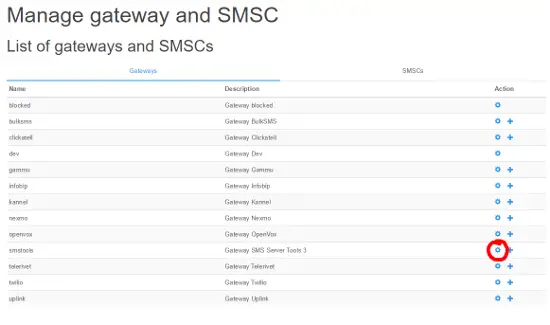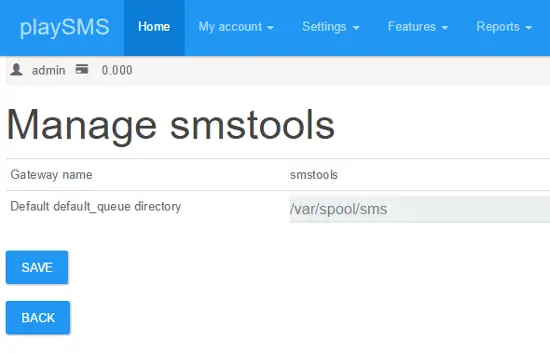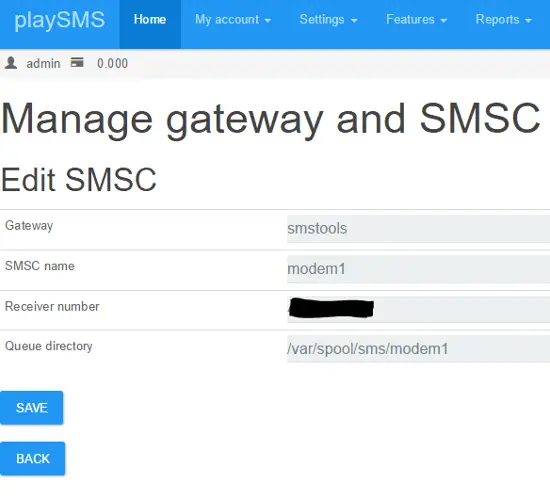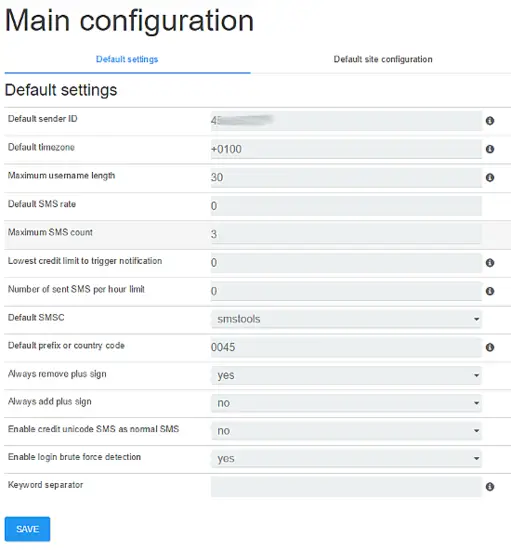Before we start
This tutorial will show you how you can set up an SMS server on a Raspberry Pi 2 Model B, running Raspbian. We will use playsms and smstools. In my example, I have used a Huawei E3131 3G modem.Raspbian
First we need to download raspbian, you can grab the latest version at https://www.raspberrypi.org/downloads/ Direct url: http://downloads.raspberrypi.org/raspbian_latest Now we need unzip the file: 2015-05-05-raspbian-wheezy.zip:unzip 2015-05-05-raspbian-wheezy.zip
You will get a file named 2015-05-05-raspbian-wheezy.img, this file must be written to your micro-sd card. If you need to know some basics on how to work with raspberry pi, and writing the image to micro-sd, you could start with reading this tutorial: https://www.howtoforge.com/tutorial/howto-install-raspbian-on-raspberry-pi/ Write image file to micro-sd card, on my PC the micro-sd card is seen as /dev/mmcblk0 on Linux you can use dd:dd bs=4M if=2015-05-05-raspbian-wheezy.img of=/dev/mmcblk0
- Please note that block size set to 4M will work most of the time; if not, please try 1M, although this will take considerably longer.
- Also, note that if you are not logged in as root you will need to prefix this with sudo.
 Now I select following options:
Now I select following options:
1 Expand Filesystem 3 Enable Boot To Desktop/Scratch -> Select Console Text Console, requiring login (default) 8 Advanced Options -> A4 SSH -> Enable 8 Advanced Options -> A0 Update Finish -> Reboot
Now you can login with following username: pi and password: raspberry. First we setup the network configuration for our server by editingsudo nano /etc/network/interfaces
My /etc/network/interfaces file looks like this (change the setup of your needs):auto lo
iface lo inet loopback
auto eth0
allow-hotplug eth0
iface eth0 inet static
address 10.255.50.30
netmask 255.255.255.0
gateway 10.255.50.1
dns-nameservers 8.8.8.8 8.8.4.4
Now we restart the network service on the Pi:
sudo /etc/init.d/networking restart
Then we disable DHCP on startup with this command:sudo update-rc.d -f dhcpcd remove
If you somehow would like to enable it again later, just run following command:sudo update-rc.d dhcpcd defaults
Now we can use an SSH client such as PuTTY to connect from our PC to the Raspberry Pi. Now we update raspbian with following command:sudo apt-get update && apt-get upgrade -y && apt-get dist-upgrade -y
PlaySMS
Download and install playsms 1.1:sudo -s apt-get install apache2 libapache2-mod-php5 mysql-server php5 php5-cli php5-mysql php5-mcrypt php5-gd php5-imap php5-curl php5enmod mcrypt service apache2 restart
When asked for the new password for the MySQL "root" user, use a strong password, in this example I have used MyP@$$w0rd Now we can go to http://your-ip, in my case http://10.255.50.30 ,and we will see a page showing: "It Works!".cd /tmp/ wget http://downloads.sourceforge.net/project/playsms/playsms/Version%201.1/playsms-1.1.tar.gz tar -zxf playsms-1.1.tar.gz -C /usr/local/src ls -l /usr/local/src/ cd /usr/local/src/playsms-1.1/ cp install.conf.dist install.conf nano install.conf
Copy install.conf.dist to install.conf and edit install.conf Read install.conf and make changes to suit your system configuration. I've edited the file, so it looks like this:# INSTALL DATA # ============ # Please change INSTALL DATA below to suit your system configurations # Please do not change variable name, you may change only the value # MySQL database username DBUSER="root" # MySQL database password DBPASS="MyP@$$w0rd" # MySQL database name DBNAME="playsms" # MySQL database host DBHOST="localhost" # MySQL database port DBPORT="3306" # Web server's user, for example apache2 user by default is www-data # note: please make sure your web server user WEBSERVERUSER="www-data" # Web server's group, for example apache2 group by default is www-data # note: please make sure your web server group WEBSERVERGROUP="www-data" # Path to playSMS extracted source files PATHSRC="$(pwd)" # Path to playSMS web files # note: please make sure your web root path, in this example its /var/www/html PATHWEB="/var/www/html/playsms" # Path to playSMS additional files PATHLIB="/var/lib/playsms" # Path to playSMS daemon and other binary files PATHBIN="/usr/local/bin" # Path to playSMS log files PATHLOG="/var/log/playsms" # END OF INSTALL DATA # ===================Now Run:
./install-playsms.sh
Press Y if everything looks OK. Now we want to make sure playsms starts on boot by adding a line into rc.local file.nano /etc/init.d/rc.local
Add following to the file: /usr/local/bin/playsmsd start on the bottom of the file (before exit if there's an exit command). This way playsmsd will start automatically on boot... /usr/local/bin/playsmsd startEdit the apache vhost file:
nano /etc/apache2/sites-available/default
My vhost file looks like this: ServerAdmin webmaster@localhost
DocumentRoot /var/www/html/playsms
Options FollowSymLinks
AllowOverride None
Options Indexes FollowSymLinks MultiViews
AllowOverride None
Order allow,deny
allow from all
ScriptAlias /cgi-bin/ /usr/lib/cgi-bin/
<directory "="" usr="" lib="" cgi-bin"="">
AllowOverride None
Options +ExecCGI -MultiViews +SymLinksIfOwnerMatch
Order allow,deny
Allow from all
ErrorLog ${APACHE_LOG_DIR}/error.log
# Possible values include: debug, info, notice, warn, error, crit,
# alert, emerg.
LogLevel warn
CustomLog ${APACHE_LOG_DIR}/access.log combined
Now reload the Aapache2 configuration to apply the changes.
service apache2 reload
Then you should be able to access the playsms website at following url: Go to http://your-ip etc. http://10.255.50.30 You can login with: username: admin password: adminGateway - SMS Server Tools 3
First we install build tools to build the latest version. Run:apt-get install build-essential libusb-1.0 libusb-1.0-0-dev
Now I have plugged in the Huawei E3131 modem, and I can see it listed with lsusb:lsusb
lsusb Bus 001 Device 002: ID 0424:9514 Standard Microsystems Corp. Bus 001 Device 001: ID 1d6b:0002 Linux Foundation 2.0 root hub Bus 001 Device 003: ID 0424:ec00 Standard Microsystems Corp. Bus 001 Device 004: ID 12d1:14fe Huawei Technologies Co., Ltd.We would like it to be with ID: 12d1:1506, but it's detected with 12d1:14fe right now. To change this, we install usb_modeswitch to the system, you can grab the latest version from here: http://www.draisberghof.de/usb_modeswitch/#download
cd /tmp wget http://www.draisberghof.de/usb_modeswitch/usb-modeswitch-2.2.5.tar.bz2 tar jxvf usb-modeswitch-2.2.5.tar.bz2 cd usb-modeswitch-2.2.5 make install cd /tmp wget http://www.draisberghof.de/usb_modeswitch/usb-modeswitch-data-20150627.tar.bz2 tar xjvf usb-modeswitch-data-20150627.tar.bz2 cd usb-modeswitch-data-20150627 make install
Now unplug the modem, and plug it in again, then run:lsusb
lsusb Bus 001 Device 002: ID 0424:9514 Standard Microsystems Corp. Bus 001 Device 001: ID 1d6b:0002 Linux Foundation 2.0 root hub Bus 001 Device 003: ID 0424:ec00 Standard Microsystems Corp. Bus 001 Device 006: ID 12d1:1506 Huawei Technologies Co., Ltd. E398 LTE/UMTS/GSM Modem/NetworkcardNow we got the desired mode: 12d1:1506. Next we proceed with SMS Server Tools 3. First we download it, then unpack it and install it.
cd /usr/local/src wget http://smstools3.kekekasvi.com/packages/smstools3-3.1.15.tar.gz tar -zxvf smstools3-3.1.15.tar.gz cd smstools3 make
If you see an error like in my case, when you run make:make cd src && make - make[1]: Entering directory '/usr/local/src/smstools3/src' Makefile:51: *** recipe commences before first target. Stop. make[1]: Leaving directory '/usr/local/src/smstools3/src' Makefile:10: recipe for target 'compile' failed make: *** [compile] Error 2Then do following:
nano src/Makefile
The problem is a missing tab, now look for:ifeq (,$(findstring DISABLE_INET_SOCKET,$(CFLAGS))) override LFLAGS += -lsocket -lnsl endifAnd move the line override LFLAGS += -lsocket -lnsl with a TAB
ifeq (,$(findstring DISABLE_INET_SOCKET,$(CFLAGS)))
override LFLAGS += -lsocket -lnsl
endif
And try to run make again:
make make install
Now we create some required folders:mkdir -p /var/log/sms/stats mkdir -p /var/spool/sms/{checked,failed,incoming,outgoing,sent} mkdir /var/spool/sms/modem1 chown www-data:www-data -R /var/spool/sms chmod 777 -R /var/spool/sms
And then move the original configuration file and download a sample from PlaySMS:mv /etc/smsd.conf /etc/smsd.conf.dist cd /tmp wget -c https://raw.githubusercontent.com/antonraharja/playSMS/master/contrib/smstools/smsd.conf cp smsd.conf /etc/
To make sure I always will use the correct device, I will use a dynamic device file. Read more about dynamic device files at following URL: http://antonraharja.com/2015/05/14/persistent-paths-for-dynamic-device-file/nano /etc/udev/rules.d/80-ttyusb-map.rules
ACTION=="add", KERNEL=="ttyUSB[0-9]*", PROGRAM="/etc/udev/rules.d/ttyusb-map.sh %p", SYMLINK+="gsm%c"
touch /etc/udev/rules.d/ttyusb-map.sh chmod 755 /etc/udev/rules.d/ttyusb-map.sh nano /etc/udev/rules.d/ttyusb-map.sh
#!/usr/bin/perl -w
@items = split("/", $ARGV[0]);
for ($i = 0; $i < @items; $i++) {
if ($items[$i] =~ m/^usb[0-9]+$/) {
print $items[$i + 1] . "\n";
last;
}
}
Now unplug, and replug your modem, and it should be located at /dev/gsm*:
ls -l /dev/gsm* lrwxrwxrwx 1 root root 7 Jul 24 01:39 /dev/gsm1-1 -> ttyUSB0 lrwxrwxrwx 1 root root 7 Jul 24 01:39 /dev/gsmmodem -> ttyUSB0
I made some changes to the file, so here is my config, my modem is located at /dev/gsm1-1 replace that with your location.# Global configuration #devices = modem1, modem2 devices = modem1 loglevel = 5 # logfiles stats = /var/log/sms/stats logfile = /var/log/sms/smsd.log # Default queue directory = /var/spool/sms outgoing = /var/spool/sms/outgoing checked = /var/spool/sms/checked failed = /var/spool/sms/failed incoming = /var/spool/sms/incoming sent = /var/spool/sms/sent # do not set report folder, let status report files saved in incoming #report = /var/spool/sms/report delaytime = 2 errorsleeptime = 10 blocktime = 180 autosplit = 3 #receive_before_send = yes incoming_utf8 = yes # Queue configurations [queues] modem1 = /var/spool/sms/modem1 #modem2 = /var/spool/sms/modem2 # Modem configurations # Modem name: modem1 # Modem type: Wavecom USB [modem1] #init = AT+CNMI=2,2,0,1,0;+CMEE=1 #init = AT+CPMS="ME","ME","ME" device = /dev/gsm1-1 baudrate = 19200 incoming = yes pin = 3391 report = yes queues = modem1 decode_unicode_text = yes cs_convert = yes # Modem name: modem2 # Modem type: Wavecom USB #[modem2] #init = AT+CNMI=2,2,0,1,0;+CMEE=1 #device = /dev/ttyUSB1 #baudrate = 115200 #incoming = yes #report = yes #queues = modem2Restart the SMS Server Tools 3:
/etc/init.d/sms3 restart
Verify if SMS Server Tools 3 is running:ps ax | grep -v grep | grep smsd
Monitor SMS Server Tools 3 log file:tail -f /var/log/smsd.log
Login and configure smstools in playsms webpanel
Login to your playsms installation my address is http://10.255.50.30/ Username is admin Password is admin Now go to Settings => Manage gateway and SMSC. You should see a screen like this: Now click to edit the smstools gateway.
And ensure it's setup like this:
Now click to edit the smstools gateway.
And ensure it's setup like this:
 Click Save, and when it's saved click back.
Now you have to setup the SMSC, so please select the + sign at SMSTools.
You should fill in the SMSC Details like this, in receiver number write your modem phone number.
Click Save, and when it's saved click back.
Now you have to setup the SMSC, so please select the + sign at SMSTools.
You should fill in the SMSC Details like this, in receiver number write your modem phone number.
 When you are done click save.
Now go to Settings => Main configuration
And fill following fields:
Default sender ID
Default prefix or country code
And set Default SMSC to smstools, like shown on the image below.
When you are done click save.
Now go to Settings => Main configuration
And fill following fields:
Default sender ID
Default prefix or country code
And set Default SMSC to smstools, like shown on the image below.
 Click save, we are ready to send first SMS.
Click save, we are ready to send first SMS.
Send an SMS
Now go to My account => Compose message Write your cell phone number in Send To, and a message etc. Hello World! in message field, and click send. If the message get's queued, you can follow transaction here: Go to Reports => All sent messages Incoming messages that are unhandled is kept in sandbox, you will this in Reports => Sandbox And log if something doesn't is located in Reports => View log If you have any trouble with your setup, a good place seek some help is playsms forum. https://forum.playsms.org/Seja Membro Gratuítamente
Assine a newsletter para receber em seu email as publicações atualizadas neste blog
